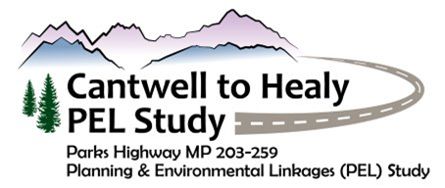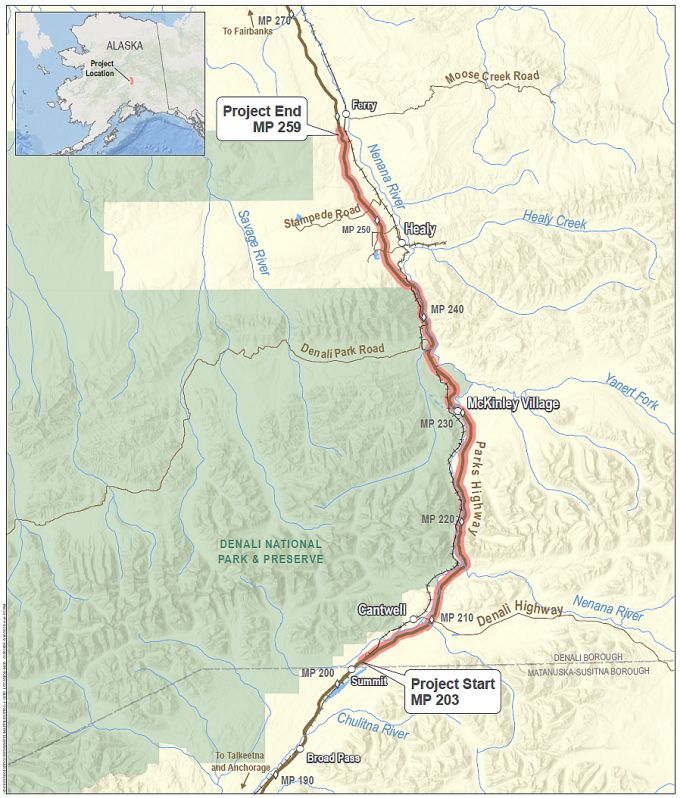
Project No. NFHWY00492
Final Planning & Environmental Linkages Study Report is now available
The Alaska Department of Transportation and Public Facilities (DOT&PF) in partnership with the Federal Highway Administration (FHWA) Western Federal Lands (WFL) and the National Park Service (NPS), worked together to identify future transportation and access improvements along the Parks Highway corridor between Cantwell and Healy.
The study team conducted a Planning and Environmental Linkages (PEL) study that looked at current and future conditions and needs of transportation and access facilities along the Parks Highway corridor as it relates to the users and communities in the areas between Cantwell and Healy.
Final PEL Study Files
Background
This PEL study process brought together regional, community, and local stakeholders for a comprehensive multi-modal look at recent, active, and future transportation improvements along the interstate highway corridor. Stakeholders, such as the DOT&PF, Denali National Park and Preserve, Denali Borough, Alaska Railroad, Native groups, local businesses, and the public came together to identify current and future needs within the study area.
The study area corridor covers the mileposts between 203 and 259, beginning just north of Broad Pass and extending north to the turnoff for the community of Ferry, including the only road-accessible entrance to Denali National Park at MP 237. The area expects a 1-2% yearly increase in traffic, and it currently experiences high volumes of commercial traffic (buses, vans, tractor trailers, and vehicles with boat trailers) as well as increased pedestrian and vehicle traffic during the primary tourist season (May to September).
This area is a focal point for visitors to the State of Alaska, the Denali area, and specifically for visitors to Denali National Park.
Study Purpose and Goals
The purpose of the study was to provide a framework for implementing future transportation improvements. A PEL study moves our ideas from the planning process more directly into the environmental review process.
PEL Study outcomes include:
- A clear and actionable PEL study that guides future transportation enhancements and development on the Parks Highway corridor.
- A PEL process that brings together regional, community, and local stakeholders for a comprehensive multi-modal look at recent, active, and future improvements along this interstate highway corridor.
PEL Study goals include:
- Collect, compile, and analyze information about the conditions and concerns along the corridor to support the identification of individual transportation projects.
- Conduct field studies (archaeology, condition reports, maintenance concerns, public concerns) and compile data already collected (crash information, deficient curves, bridge conditions) that will focus the areas of greatest attention and anticipate future needs to address.
- Develop and evaluate possible solutions to the concerns identified.
- Identify projects, termini, costs, and range needed to effectively address concerns in a timely manner.
- Assessing needs and opportunities
- Developing conceptual improvement options
- Preparing the PEL Study, which includes a plan for future project implementation
Schedule
We are done! The PEL study started in early 2020 and was completed in early 2022.
The PEL process and study was conducted in consultation with the public, stakeholders, and federal and state resource agencies and tribes. Our project advisory committee (PAC) provided guidance and input throughout the study duration. The PAC consisted of representatives from DOT&PF, FHWA, NPS, tribes, Denali Borough, local communities, other public agencies, trucking industry, railroad industry, tourism businesses, local businesses, non-motorized users, and environmental groups.
Public meetings were held during three main phases of the study:
We are excited to see the recommended projects move forward as these projects are funded.
Project Information
For information contact:
Jennifer Wright, P.E.
DOT&PF
Project Delivery Lead
2301 Peger Rd Fairbanks, AK 99709-5316
![]() 371-8949
371-8949
![]() Jennifer.Wright@alaska.gov
Jennifer.Wright@alaska.gov
To correspond by text telephone
(TDD) (907) 451-2363
PLEASE NOTE: Adobe Acrobat PDF files require a free viewer available directly from Adobe.


